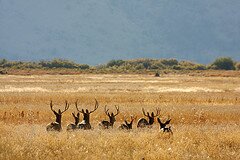Wildlife and Cattle Management on a Working Ranch
The proper type of grazing is also one of the best means of managing for wildlifeBy: Amos S. Eno
Posted on:08/19/2011 Updated:08/25/2011
This post is a continuation of our long-running series on the Chilton Ranch in southeast Arizona, a place where so many touchstone issues of the American West come together.
Jim Chilton bought his Arivaca ranch in 1987, but he’s owned another ranch, the Diamond Bell, with his dad and his brother since 1979. The Diamond Bell consists of 45 square miles with no natural water, and there is no natural water for another 20 miles in every direction of the compass.

However, because the Chiltons have developed water sources, including wells and pipelines, none of their cattle need walk more than 1 1/2 miles to get to water. This ensures not only that cattle are well distributed across the land, but it also means wildlife have water to drink. The upshot is that the Diamond Bell supports a huge mule deer herd that otherwise could not exist there.
“Ranchers in general are passionately concerned about the health and welfare of our cattle and wildlife,” Jim tells me. “We enjoy wildlife as much as or more, perhaps, than anyone else, and our stewardship helps wildlife of all kinds.”
Mule deer bucks. Photo by USFWS.
The “oops” of Good Intentions
No one gets it right all the time, and Jim has seen his share of stewardship mistakes. For example, at a natural spring on Jim’s Arivaca ranch, a government agency once insisted that he put a fence around the spring to keep the cows out. Problem was, the cows loved to nibble down those water hogging trees. When grazing was halted, the trees multiplied and grew and soon the spring had dried up.
On a neighboring ranch, part of the Sycamore canyon is one of the only places in the country that supports the 4-inch Sonora Chub - a U.S. fish species, categorized as threatened, that is common in Mexico. “It’s not really so much a stream,” explains Jim, “as a series of pools in a gorgeous canyon. One artificial pool at a crossing where the road between Arivaca and Nogales went through the normally dry wash tended to have water all the time - and lots of Sonora Chub minnows! When somebody drove to the right of the pool to avoid it, making a rut, a few chub swam into the rut, but then it dried up. That meant lots of dead chubs - not good. So then the government built a $1 million bridge on this little-used dirt road, and the wash crossing filled up with sand permanently - and then the chub disappeared!”
Our next posts will fulfill my promise, at the outset, to tell you why the US Fish & Wildlife Services endangered species folks just might want to offer Jim a job (am I joking?).

